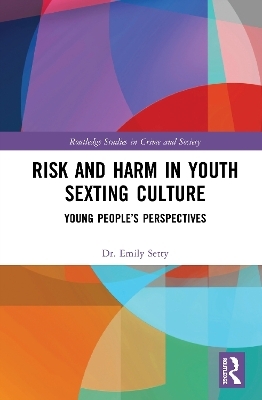
Risk and Harm in Youth Sexting
Routledge (Verlag)
978-0-367-22879-8 (ISBN)
The book explores young people’s attitudes toward and experiences of non-consensual sexting and privacy violations. It analyses the broader sociocultural context to youth sexting and discusses issues such as victim-blaming, social shaming and bullying within youth sexting culture. It reflects upon the nature of predominant approaches to responding to youth sexting (both legal and educational/pedagogic) and identifies what young people want and need when it comes to addressing risk and harm, based upon what the evidence shows about their situated realities and lived experiences.
Public and academic discourse surrounding youth sexting, and the legal and educational policy responses to the phenomenon have developed and changed over recent years. The field is increasingly contested and there are ongoing debates about how to protect young people from harm while respecting their rights as individuals and encouraging them to develop into ethical sexual citizens, including within digital environments. This book presents empirical data to show how risk and harm in youth sexting culture is predicated upon a denial of rights to sexual and bodily integrity, autonomy and legitimacy.
Dr. Emily Setty is a Lecturer in Criminology at the University of Surrey. Emily undertakes research with young people exploring their practices and experiences within their youth sexual and relational cultures. Emily is particularly interested in their perspectives on risky and harmful practices and in developing more youth-centred, impactful approaches to engaging with young people about the issues they face.
1. Chapter 1 – Introduction
Abstract
Conceptualising youth sexting
Youth sexting as a technology-facilitated expression of the sexualisation of children and young people
The meaning of ‘childhood’ and ‘youth’
Youth sexting as a sociocultural phenomenon
Researching youth sexting: Methodology and scope
Chapter outline
References
2. Chapter 2 – The legal and educational policy context to youth sexting
Abstract
Youth sexting as risky and harmful
The law and youth-produced sexual imagery
Educational responses to youth sexting
Gender, risk and sexting education
Youth sexting as a ‘moral panic’
‘Rights’, ‘agency’, ‘legitimacy’ and youth sexting
References
3. Chapter 3 – Young people, technology and sexting
Abstract
Young people and technology
Young people’s perceptions of sexting
Sexting, gender and relationships
Sexting and gender
Sexting and relationships
Conclusion
References
4. Chapter 4 – Privacy violations in youth sexting culture
Abstract
Young people, privacy and technology
Young people, sexting and privacy
Gender and (stigmatised) sexual and bodily expression
Peer status hierarchies and ‘popularity’ dynamics
Conclusion
References
5. Chapter 5 – Sexting and consent: Unwanted, pressured and coerced image-sharing
Abstract
The pleasures and rewards of sexting
Feeling ‘used’ and saying ‘no’ to sexting
Pressured and coerced sexting
Unsolicited image-sharing
Conclusion
References
6. Chapter 6 – Social shaming and victim blaming
Abstract
Managing risk and avoiding harm
Victim blaming and social shaming
‘Deserving’ and ‘undeserving’ victims
Negotiating shame and stigma
Skye-Rose and Charlie – Resisting the shame
Redefining bodily and sexual expression: ‘Frexting’
Conclusion
References
7. Chapter 7 – Responding to youth sexting: Young people’s perspectives
Abstract
Prohibiting sexting and encouraging abstinence
Early intervention
Sex(ting) education and interventions
Empowering young people: Peer-based support and bystander intervention
Conclusion
References
8. Chapter 8 – Reducing risk and harm in youth sexting: Conclusions and ways forward
Abstract
Youth sexting as a cultural phenomenon
Rights and ethics
Sexting preventative education and interventions
Taking a new approach to education and interventions
Recommendations for policy and practice
References
| Erscheinungsdatum | 22.05.2020 |
|---|---|
| Reihe/Serie | Routledge Studies in Crime and Society |
| Zusatzinfo | 7 Tables, black and white |
| Verlagsort | London |
| Sprache | englisch |
| Maße | 156 x 234 mm |
| Gewicht | 435 g |
| Themenwelt | Sachbuch/Ratgeber ► Gesundheit / Leben / Psychologie |
| Geisteswissenschaften ► Psychologie ► Pädagogische Psychologie | |
| Recht / Steuern ► EU / Internationales Recht | |
| Recht / Steuern ► Strafrecht ► Besonderes Strafrecht | |
| Sozialwissenschaften ► Pädagogik ► Bildungstheorie | |
| Sozialwissenschaften ► Pädagogik ► Didaktik | |
| Sozialwissenschaften ► Pädagogik ► Sozialpädagogik | |
| Sozialwissenschaften ► Soziologie | |
| ISBN-10 | 0-367-22879-3 / 0367228793 |
| ISBN-13 | 978-0-367-22879-8 / 9780367228798 |
| Zustand | Neuware |
| Haben Sie eine Frage zum Produkt? |
aus dem Bereich


